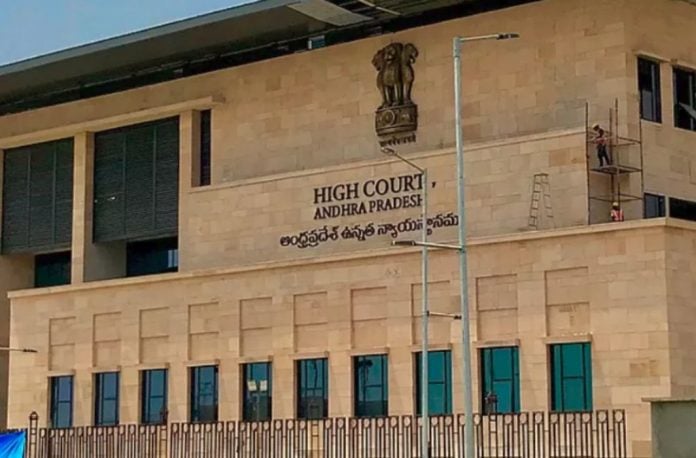The Andhra Pradesh High Court dismissed a Public Interest Litigation (PIL) filed questioning the proceedings of the Commissioner (6th respondent) dated 02.03.2023 approving the residential layout plan submitted by the Private Limited (8th respondent).
According to the petitioner, 8th respondent was allotted area in Madhurawada Village and Rural Mandal, Visakhapatnam District, for establishment of Film Studio and allied industries, specifically mentioning that conditions stipulated in Board of Revenue Standing Order 24 shall be applicable.
It is stated in the affidavit that upon application made by the 8th respondent, Joint Collector has issued NOC on 22.10.2009, but the same was subsequently cancelled/withdrawn on 29.12.2009. Under the impugned proceedings, residential layout plan of the 8th respondent has been approved to an extent , which is in violation of BSO 24.
The Division Bench of Chief Justice Prashant Kumar Mishra and Justice Ninala Jayasurya observed that “What is the public interest that would be served in filing the writ petition, has not been clearly spelt out in the affidavit. It is not a case where any marginalized or underprivileged stratum of society is affected by the impugned proceedings. Merely based on some allegation that there is an irregularity, every order of the Government cannot be examined in a public interest litigation.”
In Tehseen Poonawalla v. Union of India – (2018) 6 SCC 72, the Supreme Court in paragraphs 96 and 97, held as under:
“96. Public interest litigation has developed as a powerful tool to espouse the cause of the marginalised and oppressed. Indeed, that was the foundation on which public interest jurisdiction was judicially recognised in situations such as those in Bandhua Mukti Morcha v. Union of India [Bandhua Mukti Morcha v. Union of India, (1984) 3 SCC 161 : 1984 SCC (L&S) 389] . Persons who were unable to seek access to the judicial process by reason of their poverty, ignorance or illiteracy are faced with a deprivation of fundamental human rights. Bonded labour and undertrials (among others) belong to that category. The hallmark of a public interest petition is that a citizen may approach the court to ventilate the grievance of a person or class of persons who are unable to pursue their rights. Public interest litigation has been entertained by relaxing the rules of standing. The essential aspect of the procedure is that the person who moves the court has no personal interest in the outcome of the proceedings apart from a general standing as a citizen before the court. This ensures the objectivity of those who pursue the grievance before the court. Environmental jurisprudence has developed around the rubric of public interest petitions. Environmental concerns affect the present generation and the future. Principles such as the polluter pays and the public trust doctrine have evolved during the adjudication of public interest petitions. Over time, public interest litigation has become a powerful instrument to preserve the rule of law and to ensure the accountability of and transparency within structures of governance. Public interest litigation is in that sense a valuable instrument and jurisdictional tool to promote structural due process.”
- Yet over time, it has been realised that this jurisdiction is capable of being and has been brazenly misutilised by persons with a personal agenda. At one end of that spectrum are those cases where public interest petitions are motivated by a desire to seek publicity. At the other end of the spectrum are petitions which have been instituted at the behest of business or political rivals to settle scores behind the facade of a public interest litigation. The true face of the litigant behind the façade is seldom unravelled. These concerns are indeed reflected in the judgment of this Court in State of Uttaranchal v. Balwant Singh Chaufal [State of Uttaranchal v. Balwant Singh Chaufal, (2010) 3 SCC 402 : (2010) 2 SCC (Cri) 81 : (2010) 1 SCC (L&S) 807] . Underlining these concerns, this Court held thus: (SCC p. 453, para 143)
“143. Unfortunately, of late, it has been noticed that such an important jurisdiction which has been carefully carved out, created and nurtured with great care and caution by the courts, is being blatantly abused by filing some petitions with oblique motives. We think time has come when genuine and bona fide public interest litigation must be encouraged whereas frivolous public interest litigation should be discouraged. In our considered opinion, we have to protect and preserve this important jurisdiction in the larger interest of the people of this country but we must take effective steps to prevent and cure its abuse on the basis of monetary and non-monetary directions by the courts.”
In the absence of the fact that the petition had been preferred in the interest of justice for large number of downtrodden persons who are unable to approach the Court and further, in view of the judgment of the Supreme Court referred supra, the petitioner is not entitled to maintain the petition in the public interest and the same is, accordingly , it is dismissed by the High Court.


